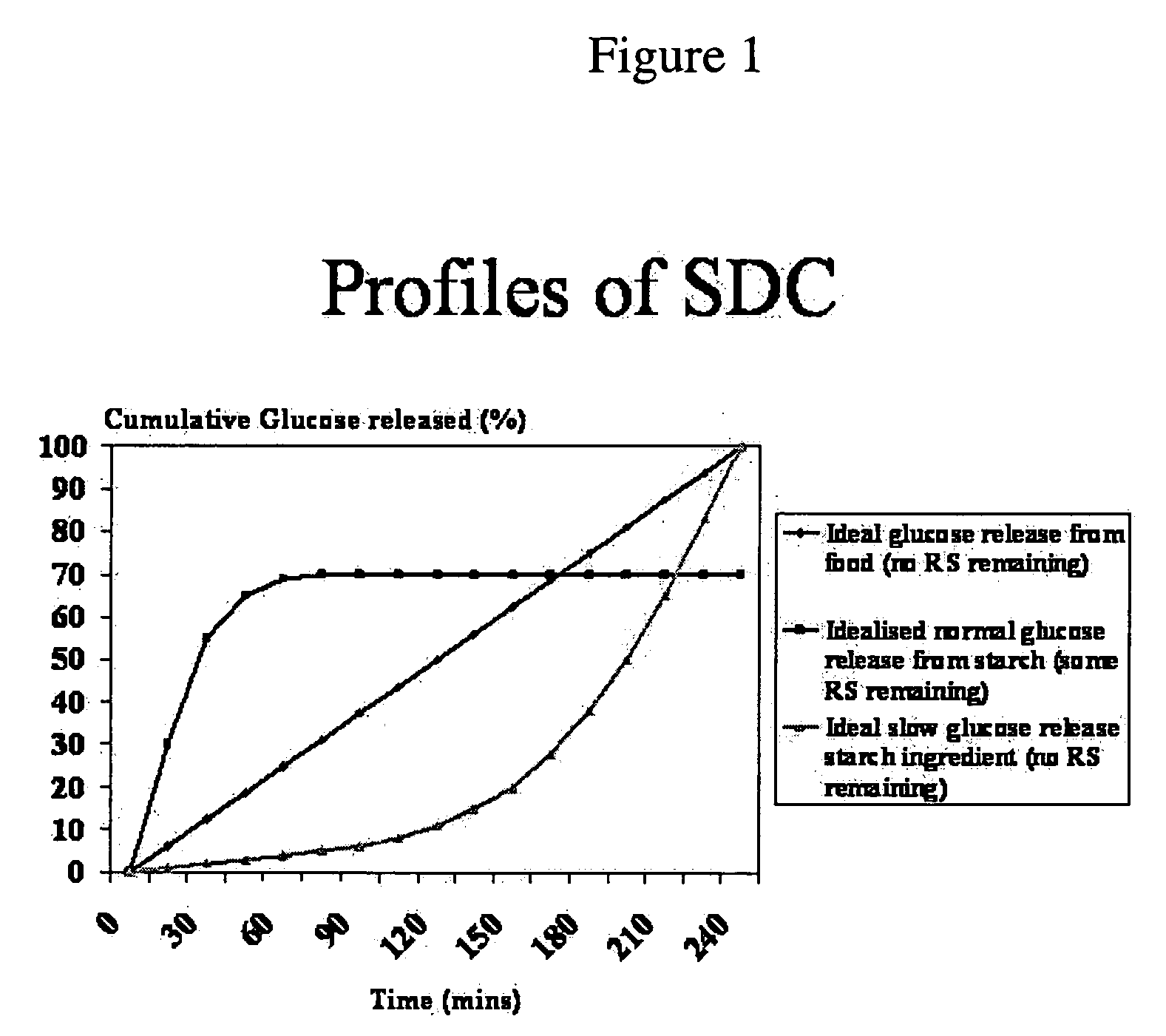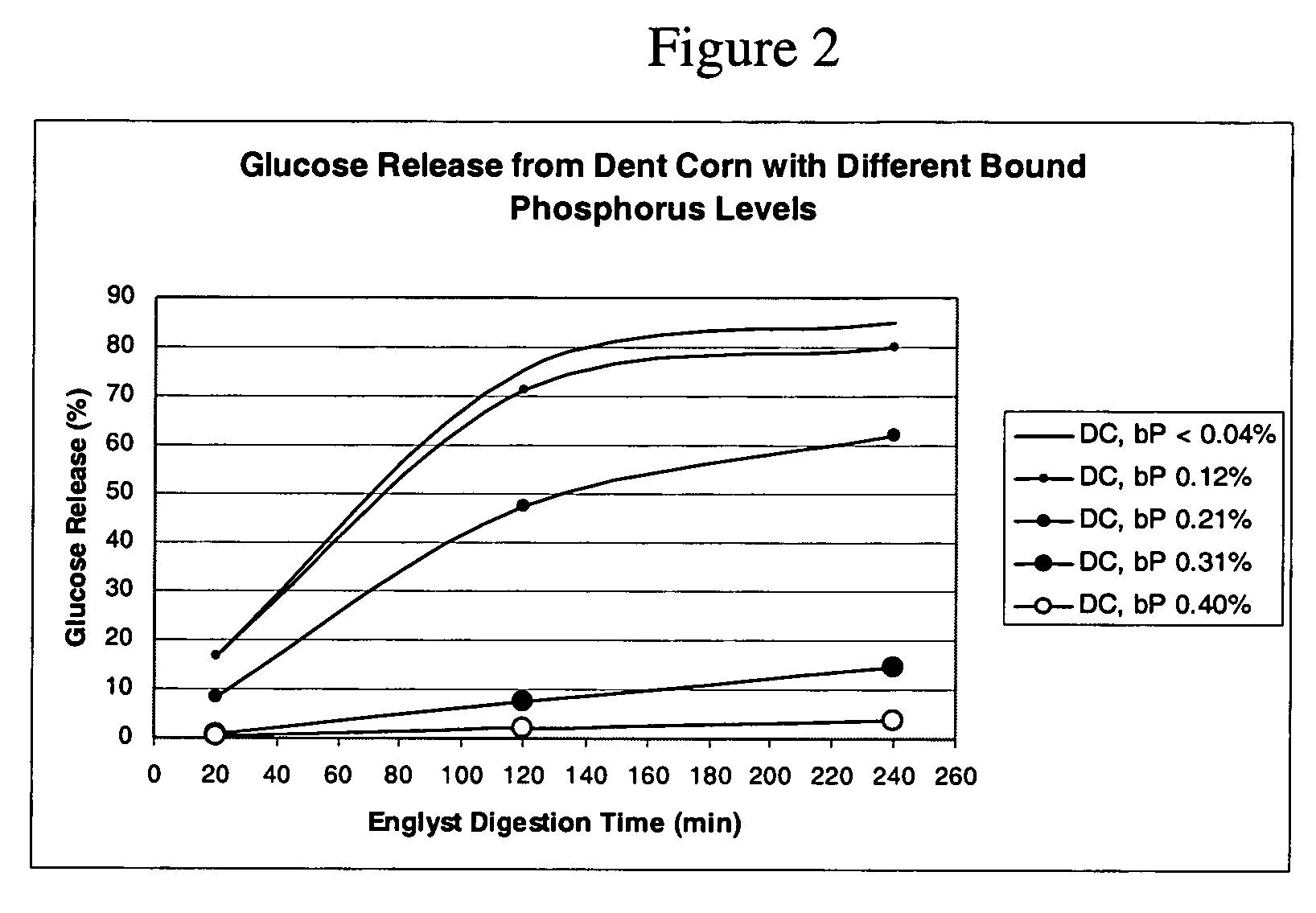Use of a chemically modified starch product
a technology of chemical modification and starch, which is applied in the field of chemical modification starch, can solve the problems of insignificant water soluble granular starch, and achieve the effect of reducing the initial acute elevation of blood glucos
- Summary
- Abstract
- Description
- Claims
- Application Information
AI Technical Summary
Benefits of technology
Problems solved by technology
Method used
Image
Examples
example 1
Preparation of Chemically Modified Starches
[0080] The following modifications are well-known in the art and the procedures are meant as guidance to the skilled artisan. Reagent amounts and bases may be changed to achieve different modification levels. [0081] a) Propylene oxide modification—4 g of solid sodium hydroxide are dissolved into 750 g of tap water at 23° C. and mixed until completely dissolved. 50 g of sodium sulfate is then added to the water and mixed until dissolved. The tapioca starch is then added quickly to the stirring aqueous mixture and mixed until uniform. Various levels of propylene oxide are added to the starch slurry and mixed for 1 to 2 minutes. The slurry is then transferred into a 2 L plastic bottle and sealed. The bottle and contents are then placed into a preheated mixing cabinet set to 40° C. and agitated for 18 hours. After the reaction is complete, the slurry is adjusted to pH 3 with dilute sulfuric acid and then allowed to mix for 30 minutes. The pH ...
example 2
Preparation of Crosslinked Starches
[0085] Sample 1—control corn starch; Melogel® starch, commercially available from National Starch and Chemical Company, Bridgewater, N.J., USA
[0086] Sample 2—3,000 ml of tap water were measured into a reaction vessel. 100 g Na2SO4 were added with agitation and stirred until dissolved. With good agitation, 2,000 g corn starch were added and then 3% NaOH was added drop-wise to the slurry as needed to reach 40 ml alkalinity (actual 667 g NaOH for 44.00 ml alkalinity). The slurry was stirred 1 hr and the pH was recorded (pH 11.68). The temperature was adjusted to 42° C. 160 g of a 99 / 1 STMP / STP blend was added and allowed to react for 4 hours. The final pH and temperature were recorded (pH 11.02 and 42° C.). The pH was adjusted to 5.5 with 3:1 HCl (pH 5.47 using 164.99 g HCl). The resultant starch case was filtered and washed twice with 3,000 ml tap water. The cake was crumbled and air dried.
[0087] Sample 3—3,000 ml of tap water was measured into a...
example 3
Glucose Release from Chemically Modified Starches
[0094] A variety of base starches were modified using PO, OSA, Acetic Anhydride reagents according to the general procedures described in the above examples to obtain a variety of modification levels. The digestibility of these starches were tested and the results are listed in Table III, below.
TABLE IIITotal BoundSample #Base StarchPhosphorus (%)ModelT = 20 minT = 120 minT = 240 min1DentN / AN / A1880852DentN / ACookie2973803Dent0.24N / A127604Dent0.12Cookie1965755Dent0.14Cookie1447566High (˜70%)N / AN / A112630Amylose7High (˜70%)N / ACookie92327Amylose8High (˜70%)0.23N / A61316Amylose9High (˜70%)0.25Cookie71618Amylose10TapiocaN / AN / A9425211Tapioca0.15Cookie14465812Waxy cornN / AN / A359410013Waxy corn0.31Cookie17506014Waxy corn0.41Cookie12313615Rice0.17N / A17556816Wheat0.21N / A226982
As can be seen from Table III, a variety of starch bases may be modified using a combination of STMP and STPP to result in the altered digestion curve of this invention i...
PUM
| Property | Measurement | Unit |
|---|---|---|
| glycemic index | aaaaa | aaaaa |
| temperature | aaaaa | aaaaa |
| particle size | aaaaa | aaaaa |
Abstract
Description
Claims
Application Information
 Login to View More
Login to View More - R&D
- Intellectual Property
- Life Sciences
- Materials
- Tech Scout
- Unparalleled Data Quality
- Higher Quality Content
- 60% Fewer Hallucinations
Browse by: Latest US Patents, China's latest patents, Technical Efficacy Thesaurus, Application Domain, Technology Topic, Popular Technical Reports.
© 2025 PatSnap. All rights reserved.Legal|Privacy policy|Modern Slavery Act Transparency Statement|Sitemap|About US| Contact US: help@patsnap.com


